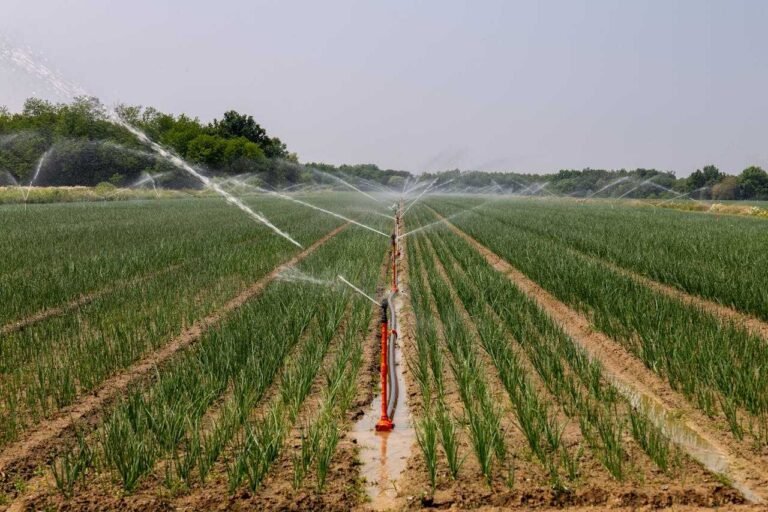Climate Change Adaptation Strategies in Agriculture
In 2023, a report by Foresight Transitions revealed that over two-thirds of the European Union’s imports of cocoa, coffee, soy, rice, wheat, and maize originated from countries with low preparedness for climate change, with cocoa being particularly vulnerable due to its reliance on nations with significantly degraded biodiversity.
This alarming statistic shows the urgent need for adaptive strategies in agriculture to mitigate the profound impacts of climate change. Farmers worldwide are experiencing firsthand the challenges posed by shifting weather patterns, increased frequency of extreme events, and evolving pest dynamics. These changes threaten crop yields, water availability, and the foundation of global food security.
In response, a myriad of innovative adaptation strategies are being employed across the globe. From conservation agriculture practices in Zambia that enhance soil health and sustain yields under warming conditions, to the adoption of solar-powered irrigation systems by Indian farmers to combat erratic rainfall, these measures exemplify the resilience and ingenuity of the agricultural community.

In This Article
Climate Change Impacts on Agriculture
Since the pre-industrial era, global average surface temperatures have risen by approximately 1.1°C, according to the Intergovernmental Panel on Climate Change (IPCC) Sixth Assessment Report. While that number might seem small, its effects on agriculture are profound and far-reaching.
Farmers worldwide are grappling with shifting weather patterns, more frequent extreme events, and changing pest dynamics. These changes threaten crop yields, water availability, and soil health, making it increasingly challenging to maintain food security.
Key Climate Impacts on Agriculture
- Increased Drought Frequency: According to a study published in Weather and Climate Extremes, droughts are becoming more frequent and severe, particularly in regions like Sub-Saharan Africa. Rain-fed crops such as maize, sorghum, and beans are especially vulnerable, leading to reduced yields and food insecurity.
- Heat Stress: Higher temperatures can cause heat stress in crops like wheat and rice, impairing their growth and reducing productivity. Extended periods of heat can also affect pollination, leading to lower grain quality and quantity.
- Flooding and Soil Erosion: Intense rainfall events can lead to flooding, which not only damages crops but also erodes topsoil, stripping away essential nutrients needed for plant growth.
- Pest and Disease Proliferation: A study published in Insects suggests that warmer climates enable pests like the fall armyworm to expand their range, attacking crops in new areas. Similarly, plant diseases can spread more rapidly, further threatening food production.
Projected Yield Changes Due to Climate Change (2050 Estimates)
| Crop | Region | Expected Change in Yield | Source |
|---|---|---|---|
| Maize | Sub-Saharan Africa | -5.8% | IPCC, 2022 |
| Wheat | South Asia | -16% | CIMMYT, 2021 |
| Rice | Southeast Asia | -12% | Nature, 2022 |
| Soybean | United States | -9% | Climate Central, 2021 |
Notes:
- Maize (Sub-Saharan Africa): The IPCC reports an average decrease of 5.8% in maize yields across Sub-Saharan Africa from 1974 to 2008 due to climate change. While specific projections for 2050 are not provided, this historical trend indicates a continuing risk to maize production in the region.
- Wheat (South Asia): A modeling study by CIMMYT predicts a 16% decline in wheat yields in South Asia by mid-century, highlighting the region’s vulnerability to climate-induced stressors.
- Rice (Southeast Asia): Research published in Nature suggests that, assuming current trends continue, the regional self-sufficiency ratio for rice in Southeast Asia will decline, indicating a potential 12% decrease in yields by 2040.
- Soybean (United States): Climate Central estimates a 9% decline in U.S. soybean yields after 2050 due to the combined effects of drought and heat stress.
Climate Change Adaptation Strategies in Agriculture
1. Adaptive Farming Techniques
Conservation Agriculture
In Zambia, farmers like Brilliant Chivunga are seeing real results from conservation agriculture (CA). This method focuses on minimal soil disturbance, keeping the ground covered with mulch, and rotating crops. Brilliant started with just one hectare using planting basins and a technique called “ripping,” which helps the soil absorb water and nutrients more effectively. Even during drought, she harvested 75 bags of maize—more than enough to feed her family and share with others.
CA helps the soil hold onto moisture, reduces erosion, and builds up organic matter. Studies in Zambia have shown that after several years of CA, soil health improves significantly, leading to better yields and more stable harvests.
Precision Agriculture
In California’s Central Valley, where water is scarce, farmers are turning to technology to make every drop count. Companies like Ceres Imaging use drones and sensors to help farmers monitor crop health and soil moisture. These tools allow growers to spot issues early and adjust irrigation precisely, saving water and boosting yields
This high-tech approach isn’t just for big farms. As tools become more affordable, small and medium-sized farmers can also benefit from data-driven decisions, leading to more efficient and sustainable farming practices.
2. Crop and Livestock Diversification
Monoculture farming—relying on a single crop—leaves farmers vulnerable to unpredictable weather patterns. Diversifying both crops and animals offers farmers a practical way to spread risk, enhance resilience, and secure their livelihoods.
Take Rwanda, for example. Many small-scale farmers there practice mixed farming—growing beans and bananas while raising goats. This approach isn’t just about variety; it’s about synergy. Goats provide manure, a natural fertiliser that enriches the soil, boosting crop yields. In fact, for many Rwandan farmers, livestock manure is the primary, if not sole, source of fertiliser, making it crucial for maintaining soil fertility.
Moreover, integrating livestock like goats, which are more drought-resistant than cattle, helps farmers adapt to changing weather patterns. This combination ensures a steady income and food supply throughout the year, even when one component faces challenges.
Research supports this integrated approach. A study highlighted that farmers who diversified both crops and livestock were more likely to adopt other climate adaptation strategies, such as using improved crop varieties and soil conservation techniques.
3. Water Management Innovations
Drip Irrigation
In regions where water is scarce, such as parts of Israel, Kenya, and India, drip irrigation has become a game-changer. This method delivers water directly to the plant roots through a network of pipes and emitters, minimising evaporation and runoff.
According to Yara International, traditional flood irrigation systems have water efficiency levels of 30-40%, whereas drip irrigation can achieve up to 95% efficiency. This significant improvement not only conserves water but also enhances crop yields.
In India, the adoption of drip irrigation has led to water savings of 30-70% for various crops compared to conventional methods. Additionally, crop productivity has increased by 30-90%, and the cost of cultivation has been substantially reduced.
A study conducted in Northwest China demonstrated that drip irrigation reduced water input and output by 21% and 62%, respectively, compared to traditional border irrigation. It also stabilised field water storage, providing optimal conditions for crop growth.
Rainwater Harvesting and Storage
Rainwater harvesting is a sustainable practice that involves collecting and storing rainwater for agricultural use. This method is particularly beneficial in areas with irregular rainfall patterns.
In Kenya, families like the Ndungus have constructed water pans—small reservoirs that collect runoff during the rainy season. These water pans provide a reliable source of water for irrigation and household use, eliminating the need to fetch water from distant sources.
Similarly, in India, initiatives like the one in Bangalore aim to dig up to one million recharge wells to collect rainwater and replenish groundwater levels. This approach not only addresses water scarcity but also promotes self-sufficiency among communities.
4. Climate-Resilient Crops and Livestock Breeds
Seed Innovation
In Bangladesh, farmers are embracing rice varieties that can withstand flooding, a frequent challenge in the region. BRRI dhan51, developed by the Bangladesh Rice Research Institute (BRRI), has shown promising results. Under direct-seeded conditions in flash flood-prone areas, BRRI dhan51 produced the highest number of effective tillers and grain yield among the tested varieties. Similarly, BRRI dhan79, another submergence-tolerant variety, can survive up to three weeks of complete submergence and has been approved for cultivation in flood-affected regions.
In Kenya, drought-tolerant maize varieties under the DroughtTEGO® brand have been introduced to help farmers cope with erratic rainfall patterns. These hybrids have demonstrated a significant yield advantage, with some varieties yielding up to 150% more than the national average. The adoption of DroughtTEGO® maize has been associated with increased productivity and household incomes, contributing to poverty reduction in drought-prone areas.
Heat-tolerant wheat varieties are also being developed to address rising temperatures. In India, varieties like DBW187 and DBW222 have shown superior heat tolerance compared to existing cultivars, with yield gains of 3.6% and 5.4%, respectively. These advancements are crucial for maintaining wheat production in regions experiencing higher temperatures due to climate change.
In Tunisia, the introduction of salt-tolerant barley varieties like Batini has enabled farmers in arid, salt-affected areas to improve yields and reduce water costs. Batini performed well under saline irrigation conditions, producing up to 2 tonnes of grain per hectare, compared to 0.7 tonnes for traditional varieties.
Livestock Adaptation
In East Africa, the Red Maasai sheep breed is valued for its resistance to internal parasites and diseases. Studies have shown that Red Maasai sheep have lower mortality rates and higher productivity compared to other breeds, making them well-suited for arid conditions.
In South Asia, Sahiwal cattle are renowned for their heat tolerance and disease resistance. These traits make them an important resource for farmers in regions facing rising temperatures and disease pressures.
Learn More: Sustainable Agriculture and Farming
5. Agroforestry and Soil Health
Trees as Climate Allies
Agroforestry—planting trees alongside crops—is more than just adding greenery. Trees like Gliricidia or Faidherbia albida provide shade that cools crops, reduces wind damage, and drop leaves that enrich the soil. In Ethiopia’s Sidama highlands, coffee farmers like those partnered with PUR Projet have integrated over 2 million trees into their farms. One farmer shared how the shade from these trees protected coffee plants from the intense sun, helping cherries ripen more evenly and improving overall quality. The fallen leaves naturally compost into the soil, enriching it without synthetic fertilisers and revitalising the local ecosystem.
Beyond shade, trees support soil biodiversity. According to a 2023 study in Soil Use and Management, agroforestry systems significantly increase beneficial soil organisms like earthworms and ants, which are vital for nutrient cycling and soil structure.
Soil Health Practices
Healthy soil is the foundation of resilient farming. Here are three practices that enhance soil health and help combat climate change:
- Cover Cropping: Planting cover crops like legumes or grasses during off-seasons protects soil from erosion, suppresses weeds, and adds organic matter. These plants also fix nitrogen, reducing the need for synthetic fertilisers.
- Composting: Turning organic waste into compost enriches the soil with nutrients and beneficial microbes. This process not only improves soil fertility but also diverts waste from landfills, reducing methane emissions—a potent greenhouse gas.
- Biochar Addition: Biochar, a charcoal-like substance made from organic materials, enhances the soil’s ability to retain water and nutrients. It also sequesters carbon, locking it in the soil for centuries, which helps mitigate climate change.
6. Social and Financial Safety Nets
Crop Insurance and Risk Pools
In Kenya, smallholder farmers are increasingly turning to innovative insurance solutions to shield themselves from the unpredictable impacts of climate change. One such solution is the Kenya Livestock Insurance Program (KLIP), which utilises satellite data to monitor vegetation levels. When these levels drop below a certain threshold, indicating drought conditions, payouts are automatically triggered to assist pastoralists in purchasing feed and water for their livestock. This approach has provided critical support to farmers during periods of severe drought, helping them maintain their livelihoods.
Similarly, picture-based insurance (PBI) schemes have been introduced, where farmers use smartphone applications to upload images of their crops at various growth stages. These images, combined with satellite data, allow for an accurate assessment of crop damage and timely insurance payouts. This method has enhanced trust in insurance processes and provided farmers with the financial means to recover from crop failures.
Community-Based Approaches
In Nepal, women-led cooperatives are playing a pivotal role in enhancing community resilience to climate change. These cooperatives pool savings to offer climate-focused loans, enabling members to invest in drought-tolerant seeds, drip irrigation systems, and solar dryers. Such initiatives not only empower women economically but also foster community solidarity in the face of environmental challenges
7. Policy and Institutional Support
Government Initiatives
In India, the Pradhan Mantri Kisan Urja Suraksha evam Utthaan Mahabhiyan (PM-KUSUM) scheme is transforming agricultural practices by promoting solar-powered irrigation. Launched in 2019, the program offers substantial subsidies to farmers for installing solar pumps, reducing reliance on diesel and grid electricity. Under the scheme, farmers can receive up to a 90% subsidy, making solar technology more accessible.
The impact is evident in states like Rajasthan, where over 1,000 MW of solar power capacity has been installed under PM-KUSUM, benefiting approximately 1.7 lakh farmers with daytime electricity for irrigation. This shift not only lowers operational costs but also contributes to environmental sustainability by reducing carbon emissions.
Extension Services and Farmer Education
In Ethiopia, the 8028 Farmers’ Hotline, established by the Agricultural Transformation Institute, serves as a vital resource for smallholder farmers. This toll-free service provides real-time agronomic advice, weather updates, and market information through voice and SMS, bridging the information gap in rural areas.
Since its inception, the hotline has received over 17 million calls from 2.2 million registered users, reflecting its widespread adoption and trust among farmers. By offering accessible and timely information, the 8028 Hotline empowers farmers to make informed decisions, enhancing productivity and resilience against climate-related challenges.
Learn More: Climate Change in 2025: Where We Stand
Conclusion:
Climate change is daunting, but farmers are not passive victims. Across the globe, they are adapting with courage, creativity, and community. Their resilience is a powerful reminder: with the right tools, support, and knowledge, agriculture can thrive in a warming world.
As you reflect on the stories and strategies shared, ask yourself:
- What practices can I adopt or advocate for?
- How can we support our farmers to innovate and lead?
Let’s water the seeds of resilience together.
Actionable Advice Checklist
- Start small: Introduce one resilient practice, like mulching or crop rotation.
- Access weather data: Use local meteorological apps or services.
- Join farmer networks: Learn from peers and share success stories.
- Explore finance options: Microloans, co-ops, or government subsidies.
- Engage youth and women: Inclusive adaptation yields better results.
Remember: Adaptation is not a luxury—it’s a lifeline.







